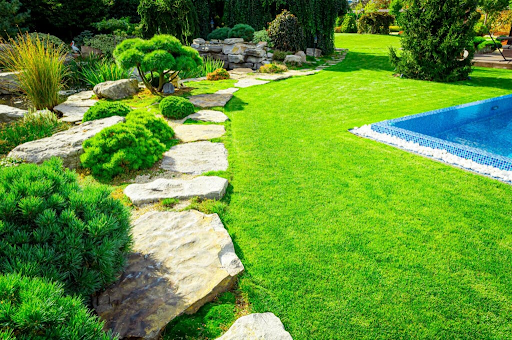In today’s fast-paced world, outdoor spaces have emerged as vital extensions of our homes and workplaces. From residential gardens to commercial landscapes, the design and maintenance of these areas are essential for aesthetic appeal and functionality. This article explores key services for transforming landscapes, focusing on site development and weed control, while also discussing other critical elements for enhancing outdoor spaces.
Site Development Services: Ensuring a Solid Foundation
Site development services are crucial for creating an effective landscape that meets specific needs and aesthetics. This process begins with a comprehensive assessment of the land, which includes analyzing topography, soil quality, drainage, and environmental factors. Skilled landscape professionals utilize this information to design layouts that are both practical and visually appealing.
One of the primary components of site development is grading, which involves adjusting the land’s slope to ensure proper drainage and prevent water accumulation. Effective grading not only enhances the landscape’s appearance but also protects structures from potential water damage.
In addition to grading, site development encompasses the installation of necessary infrastructure, such as pathways, retaining walls, and drainage systems. These elements contribute to the landscape’s functionality while enhancing its overall design. A well-planned site development service lays the groundwork for successful landscape projects, ensuring that they are sustainable and easy to maintain.
Weed Control Services: Maintaining Aesthetic Appeal
Weeds can quickly diminish the beauty of any landscape, competing with desirable plants for nutrients, water, and sunlight. Effective weed control services are essential for maintaining the health and visual appeal of outdoor spaces. These services typically include a combination of preventative measures and active management strategies to keep weeds at bay.
Preventative measures may involve the use of mulch, ground covers, or landscape fabric, which can suppress weed growth while promoting the health of desirable plants. Regular maintenance, including mowing, edging, and hand-pulling, helps to keep weed populations under control.
When weeds become pervasive, targeted treatments such as herbicides may be necessary. Professional weed control services utilize integrated pest management (IPM) techniques to ensure that these treatments are effective while minimizing harm to the surrounding environment. This approach combines cultural, mechanical, and chemical methods to manage weed populations sustainably.
Landscape Design: Creating Visual Harmony
A well-designed landscape is a harmonious blend of natural elements, plants, and structures that enhance the aesthetic appeal of an outdoor space. Professional landscape design services focus on creating cohesive designs that complement the architecture of the surrounding environment.
Designers consider various factors, including the local climate, soil conditions, and the intended use of the space. They often incorporate native plants, which require less maintenance and provide ecological benefits by supporting local wildlife. A well-thought-out design not only elevates the visual impact of a space but also increases property value and improves the overall quality of life for residents and visitors.
Hardscaping: Enhancing Functionality and Appeal
Hardscaping refers to the incorporation of non-plant elements into landscape design, such as patios, walkways, walls, and other structures. These features serve both functional and aesthetic purposes, allowing for the creation of usable outdoor areas.
Patios and decks provide spaces for relaxation and entertainment, while walkways ensure safe and accessible movement throughout the landscape. Retaining walls can prevent soil erosion and create terraced planting areas, adding depth and dimension to the overall design.
Quality hardscaping services can significantly enhance the functionality and appeal of outdoor spaces, making them more enjoyable and usable for various activities.
Irrigation and Drainage Solutions: Optimizing Water Usage
Proper irrigation and drainage systems are essential for maintaining healthy landscapes. These systems ensure that plants receive adequate water while preventing overwatering, which can lead to root rot and other issues.
Professional irrigation services include the design and installation of efficient watering systems, such as drip irrigation or sprinkler systems, tailored to the specific needs of the landscape. Regular maintenance ensures these systems operate effectively, optimizing water usage and promoting plant health.
Drainage solutions, such as French drains and dry wells, help to manage excess water and prevent pooling in the landscape. By effectively managing water flow, these systems protect the integrity of hardscaping features and contribute to the longevity of the landscape design.
Tree and Shrub Care: Promoting Healthy Growth
Trees and shrubs are integral components of any landscape, providing shade, beauty, and habitat for wildlife. Professional tree and shrub care services include pruning, disease management, and planting techniques that promote healthy growth and enhance the overall landscape.
Regular pruning helps maintain the shape and health of trees and shrubs while reducing the risk of disease and pest infestations. Additionally, proper planting techniques ensure that these plants establish themselves effectively in their new environment, contributing to the landscape’s overall success.
Conclusion
Transforming outdoor spaces requires a multifaceted approach that includes site development, weed control, and other essential services. By investing in these professional services, property owners can create and maintain beautiful, functional landscapes that enhance their living and working environments. Whether through careful planning, effective maintenance, or innovative design, the potential for outdoor spaces is limitless, providing a canvas for creativity and enjoyment in our everyday lives.


